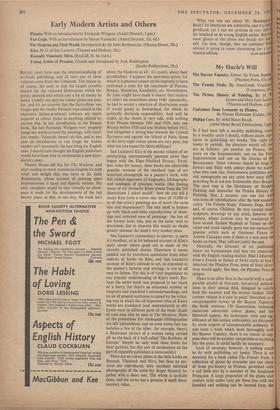Early Modern Artists and Others
Picasso. With an introduction by Fernanda Wittgens. (Andre Deutsch, 3 gns.) Van Gogh. With an introduction by Marco Valsecchi. (Andre Deutsch, 52s. 6d.) The Moderns and Their World. Introduction by Sir John Rothenstein. (Phcenix House, 30s.) Rouault; Vlaminck; Miro. (Rockliff, 8s. 6d. each.) Young Artists of Promise. Chosen and introduced by Jack Beddington.
(Studio Publications, 30s.)
RECENT years have seen the internationalising of art-book publishing, and all save one of these volumes come from the Continent. The reason is, of course, the need to find the largest possible market for the coloured illustrations which the public demand and which cost a lot of money to make. Usually one gets the colour plates one pays for, and it's no surprise that the thirty-three van Goghs and the twenty Picassos reproduced in the expensive Italian-produced volumes are much superior as colour plates to anything offered by anyone else. In her introduction to the Picasso book, the late Fernanda Wittgens very properly hangs her words around the paintings, with excel- lent results. Valsecchi doesn't do this, and in any case an introduction to van Gogh for Italian readers isn't necessarily the best thing for English ones. Ishould have thought the English publishers would have been wise to commission a new intro- ductory essay.
Phcenix House did this for The Moderns, and after reading so much translation-English it's with relief and delight that one turns to Sir John Rothenstein, whose account of painting since Impressionism is lucid and fluently written. My only complaint would be that virtually no allow- ance is made for the developments of the last twenty years, so that, in one way, the book isn't about the Moderns at all: it's mostly about their grandfathers. I suppose the enormous public for which it is planned cannot yet be expected to have cultivated a taste for the successors of Picasso, Braque, Mondrian, Kandinsky, etc. Nevertheless, Sir John might have made it clearer that modern art didn't die somewhere about 1940. Admittedly, he had to accept a selection of illustrations made (I would guess) in Switzerland, for which he pointedly disclaims responsibility. And well he might, as the choice is very odd, with nothing from Picasso between 1901 and 1920, only one Braque before 1926 and one Matisse before 1917, and altogether a strong bias towards the Central European and against the School of Paris. Some of the forty-eight colour plates are very poor, but what can you expect for thirty shillings?
San Lazzaro's Klee is the second volume of an enterprising internationally planned series that began with the Elgar-Maillard Picasso. Excel- lent value for money, these books are admirable popular versions of the standard type of art historical monograph on a painter's work, with full critical apparatus of biography, bibliography and catalogue of principal works. (But finding many of my favourite Klees absent from the 393 illustrations I asked myself : how do you tell a major Klee from a minor one, since all 10,000 or so of this artist's paintings are of much the same size and importance?) The text itself is broken up with black-and-white reproductions of draw- ings and coloured ones of paintings : the line of the former lacks bite, just as the latter tend to muzziness, but to improve this would no doubt greatly increase the book's very modest price.
San Lazzaro's commentary is uneven; in parts it's excellent, as in his balanced account of Klee's early career where good use is made of the recently published diaries. Elsewhere it seems padded out by enormous quotations from other authors of books on Klee, and San Lazzaro's account of Klee's attitude to art, as expressed in the painter's lectures and writings, is not at all easy to follow. Yet this is of vital importance to any popular understanding of Klee's work. Per- haps the entire book was prepared in too much of a hurry, for there's an abnormal number of misprints and translator's misunderstandings, and an air of general confusion is caused by the irritat- ing way in which the all-important titles of Klee's works are translated (and mistranslated) in dif- ferent ways in different parts of the book. (Lack of care may also be seen in The Moderns. Parts of the pretentious but inadequate bibliographies are left untranslated, and an even worse fate has befallen a few of the titles: for example, there's a Beckmann picture of a woman being carried off on the back of a bull called 'The Robbery of Europe.' Maybe we only want these books for their pictures, but this sort of carelessness on the part of reputable publishers is inexcusable.)
There are no colour plates in the little books on Rouault, Vlaminck and Miro, but then no pic- tures are reproduced, only excellent informal photographs of the artist (by Roger Hauert), to- gether with a short text. The whole is tactfully done, and the series has a genuine if small docu- mentary value.
SPECTATOR, DECEMBER 20, IC SalTI book? Its intentions are admirable, and it's nicdY produced, yet I can see promise in very few ni must glance at the plates and decide for your' abroad is going to come clamouring for a con' tinental edition.T•55 his hundred or so young English artists. But self. I'm sure, though, that no publisher frofc What can one say about Mr. Beddington' ALAN BOW' wt


































 Previous page
Previous page